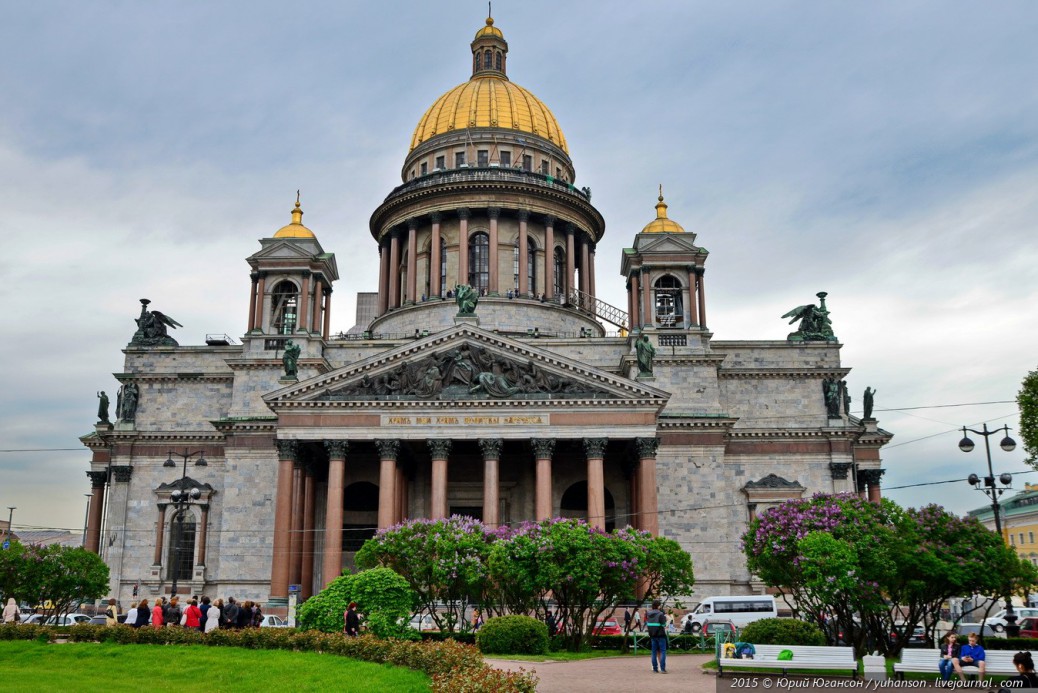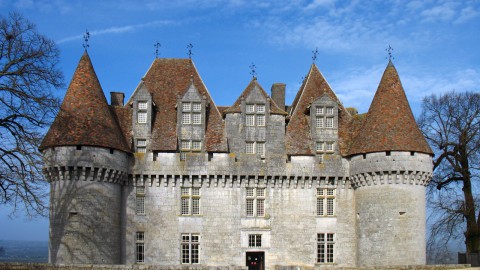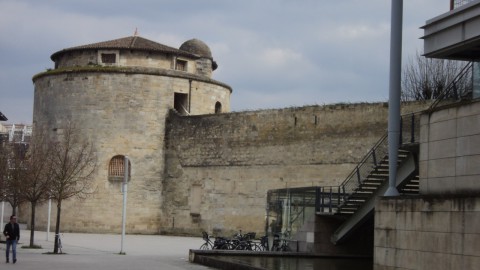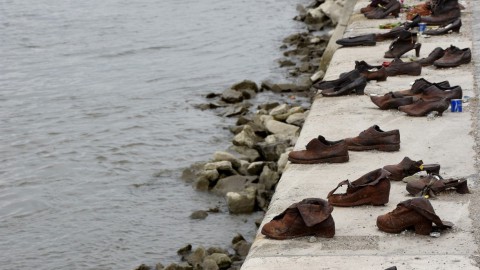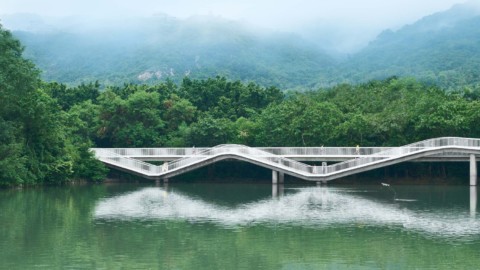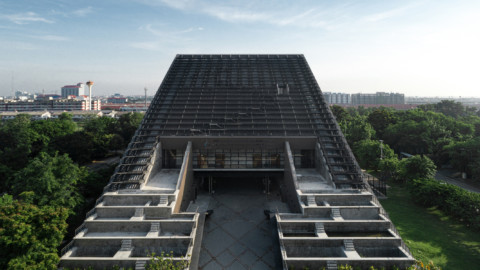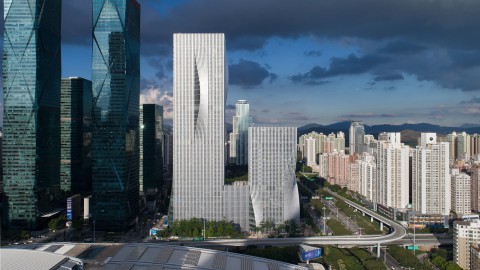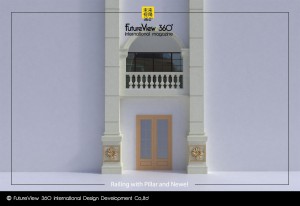Saint Isaac’s Cathedral 聖以撒大教堂
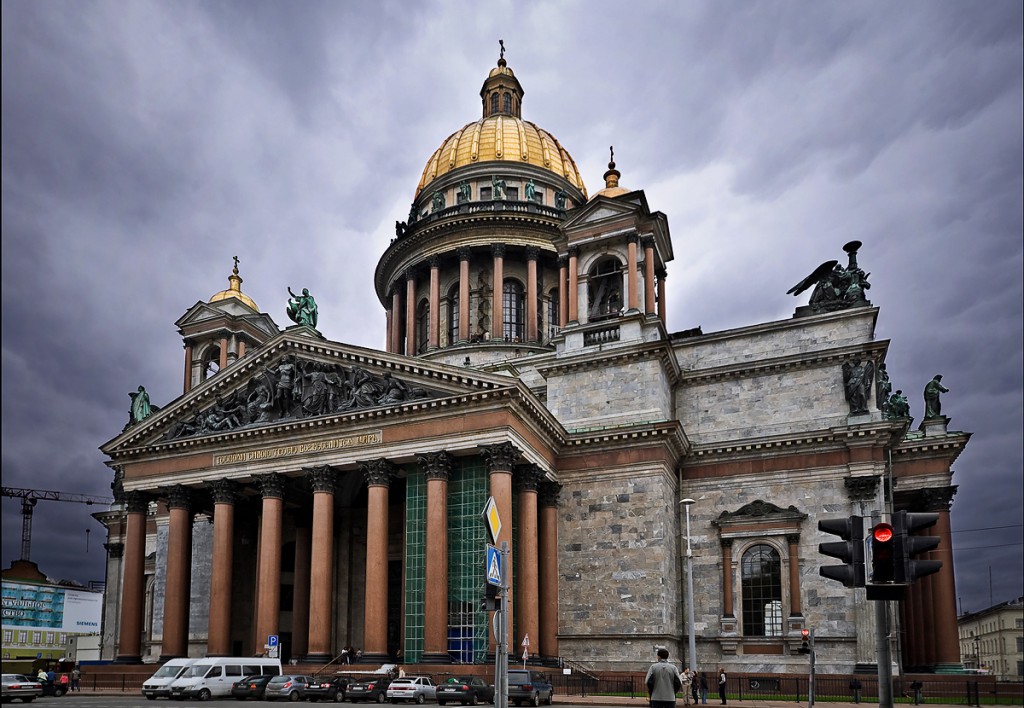
Saint Isaac’s Cathedral or Isaakievskiy Sobor (Russian: Исаа́киевский Собо́р) is a cathedral that currently functions as a museum in Saint Petersburg, Russia. It is dedicated to Saint Isaac of Dalmatia, a patron saint of Peter the Great, who had been born on the feast day of that saint. It was originally built as a cathedral but was turned into a museum by the Soviet government in 1931 and has remained a museum ever since. In 2017, the Governor of Saint Petersburg offered to transfer the cathedral back to the Russian Orthodox Church, but the church has not exercised this offer.
聖以撒大教堂或Isaakievskiy Sobor(俄語:ИсаакиевскийСобор)是一座大教堂,目前在俄羅斯聖彼得堡作為博物館。 它致力於達爾馬提亞的聖艾薩克,他是彼得大帝的守護神,他出生在聖徒的節日。 它最初是作為一座大教堂建造的,但在1931年由蘇維埃政府改建為博物館,此後一直是博物館。 2017年,聖彼得堡總督提出將大教堂轉移回俄羅斯東正教會,但教堂尚未行使此項要約。
Religion
Affiliation:Russian Orthodox
Status:Museum (main utility)
Location
Location:Saint Isaac’s Square 4,
Saint Petersburg
Architecture
Architect(s):Auguste de Montferrand
Architectural style:Late Neoclassical, Byzantine and Greek (cross church)
Completed:1858
Specifications
Capacity:14,000
260,000 m3 (volume)
Length:104.5 m (interior)
111.3 m (exterior-stairs)
Width:91 m (interior)
97.6 m (exterior-stairs)
Interior area:7,000 m² (interior)
8,000 m² (exterior-stairs)
Height (max) :101.5 m (top cross)
Dome dia. (outer):25.8 m
宗教
隸屬:俄羅斯東正教
狀態:博物館(主要實用工具)
位置
地點:聖艾薩克廣場4號,
聖彼得堡
架構
建築師:Auguste de Montferrand
建築風格:晚新古典主義,拜占庭主義和希臘主義(跨教會)
完成時間:1858年
產品規格
容量:14,000
260,000立方米(體積)
長度:104.5米(室內)
111.3米(外部樓梯)
寬度:91米(室內)
97.6米(室外樓梯)
內部面積:7000平方米(室內)
8,000m²(外部樓梯)
高度(最大):101.5米(頂部十字架)
圓頂滑動。 (外):25.8米
History
The church on St Isaac’s Square was ordered by Tsar Alexander I, to replace an earlier structure by Vincenzo Brenna, and was the fourth consecutive church standing at this place. A specially appointed commission examined several designs, including that of the French-born architect Auguste de Montferrand (1786–1858), who had studied in the atelier of Napoleon’s designer, Charles Percier. Montferrand’s design was criticised by some members of the commission for the dry and allegedly boring rhythm of its four identical pedimented octastyle porticos. It was also suggested that despite gigantic dimensions, the edifice would look squat and not very impressive. The members of the commission, which consisted of well-known Russian architects, were also particularly concerned by necessity to build a new huge building on the old unsecure foundation. The emperor, who favoured the ponderous Empire style of architecture, had to step in and solve the dispute in Montferrand’s favour.
The cathedral took 40 years to construct, under Montferrand’s direction, from 1818 to 1858. The building of the cathedral took so long, that it left an idiom to Finnish language: rakentaa kuin Iisakinkirkkoa (To build church of Isaac) when speaking of long-term construction projects.
To secure the construction, the cathedral’s foundation was strengthened by driving 25,000 piles into the fenland of Saint Petersburg. Innovative methods were created to erect the giant columns of the portico. The construction costs of the cathedral totalled an incredible sum of 1 000 000 gold rubles. Under the Soviet government, the building was stripped of religious trappings. In 1931, it was turned into the Museum of the History of Religion and Atheism, the dove sculpture was removed, and replaced by a Foucault pendulum. On April 12, 1931, the first public demonstration of the Foucault pendulum was held to visualize Copernicus’s theory. In 1937, the museum was transformed into the museum of the cathedral, and former collections were transferred to the Museum of the History of Religion (located in the Kazan Cathedral).
During World War II, the dome was painted over in gray to avoid attracting attention from enemy aircraft. On its top, in the skylight, a geodesical intersection point was placed, to determine the positions of German artillery batteries.
With the fall of communism, the museum was removed and regular worship activity has resumed in the cathedral, but only in the left-hand side chapel. The main body of the cathedral is used for services on feast days only.
On January 10, 2017 Georgy Poltavchenko, the Governor of St. Petersburg, announced that the cathedral would be transferred to the Russian Orthodox Church . The key protocols of the transfer were defined by the order issued by St. Petersburg’s Committee on Property Relations on December 30, 2016. The document expired on December 30, 2018. The new order can be issued upon request from the Russian Orthodox Church, but no such request has yet been submitted.
The transfer of Saint Isaac’s Cathedral in use the ROC agreed in January 2017, but the decision has caused discontent of the townspeople, who defended the status of the museum. The decision of the city authorities was disputed in the courts.Currently, the status of the building is museum. Today, church services are held here only ecclesiastical occasions.
歷史
沙皇亞歷山大一世命令聖艾薩克廣場上的教堂取代文森佐·布倫納的早期建築,並且是連續第四個站在這個地方的教堂。一個特別委員會審查了幾個設計,包括法國出生的建築師奧古斯特德蒙特弗蘭德(1786-1858),他曾在拿破崙設計師查爾斯·佩西爾的工作室學習過。蒙特弗朗德的設計受到了一些委員會的批評,因為它的四個相同的八卦風格的門廊的干燥和據稱的鑽孔節奏。還有人認為,儘管巨大的尺寸,大廈看起來會蹲下而不是很令人印象深刻。該委員會的成員由著名的俄羅斯建築師組成,他們也特別關注在舊的不安全的基礎上建造一座新的巨型建築的必要性。皇帝喜歡沉重的帝國建築風格,不得不介入並解決蒙特弗蘭德的爭議。
從1818年到1858年,在蒙特弗蘭德的指導下,大教堂用了40年的時間建造。大教堂的建築花了很長時間,它留下了芬蘭語的成語:rakentaa kuin Iisakinkirkkoa(建造艾薩克教堂)期限建設項目。
為了確保建設,大教堂的基礎得到了加強,在聖彼得堡的芬蘭地區開了25,000個樁。創建了創新方法來推廣門廊欄目。大教堂的建築成本總計達到1,000,000金盧布。在蘇維埃政府期間,該建築被剝奪了宗教信仰。 1931年,它變成了歷史和宗教博物館,鴿子雕塑被移除,取而代之的是福柯鐘擺。 1931年4月12日,首次公開展示了福柯鐘擺,以展示哥白尼的理論。 1937年,博物館被改造成大教堂博物館,形式被轉移到宗教歷史博物館(位於喀山大教堂)。
在第二次世界大戰期間,圓頂被塗成灰色,以避免引起敵機的注意。在它的頂部,在天窗中,放置了一個測地交叉點,以確定德國砲兵電池的位置。
隨著共產主義的垮台,博物館被拆除,大教堂也定期進行定期的祭祀活動,但僅限於左側的小教堂。大教堂的主體僅在節日時提供服務。
2017年1月10日,聖總督Georgy Poltavchenko聖彼得堡宣布它將被轉移到俄羅斯東正教會。轉移的關鍵協議由st發布的命令定義。彼得堡物業關係委員會於2016年12月30日簽署。該文件於2018年12月30日到期。新訂單可應俄羅斯東正教會的要求發出,但未提交此類請求。
使用中華民國的聖艾薩克大教堂於2017年1月同意轉移,但該決定引起了市民的不滿,他們為博物館的地位辯護。市法院的決定在法庭上受到質疑。今天,教堂服務只在這裡舉行教會活動。
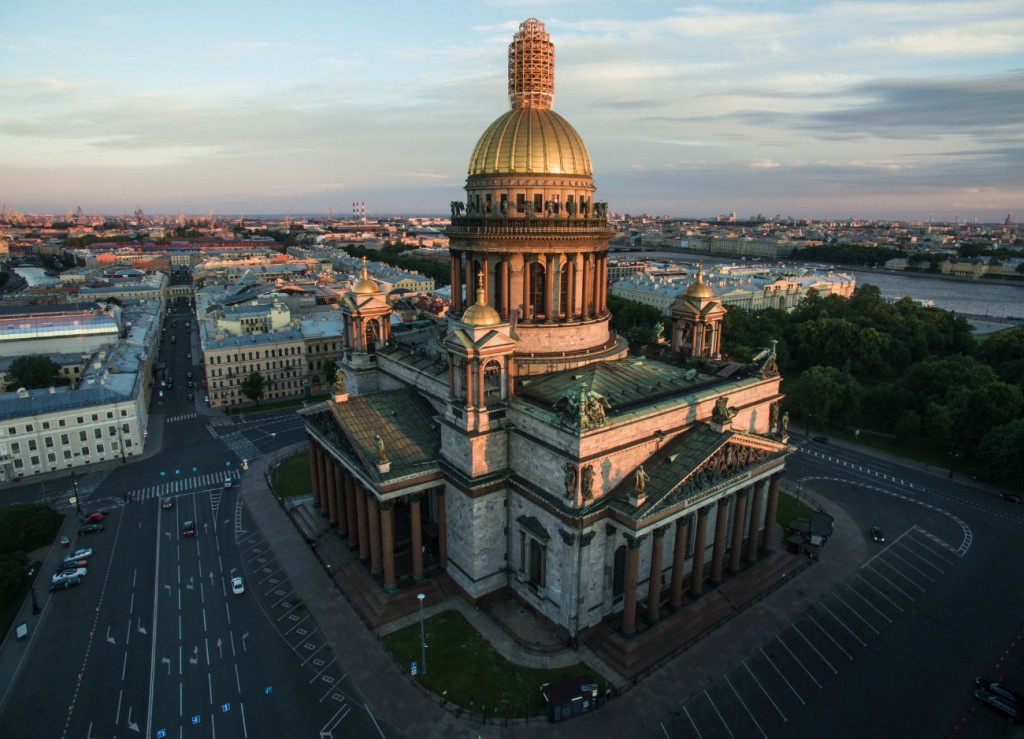
Exterior
The neoclassical exterior expresses the traditional Russian-Byzantine formula of a Greek-cross ground plan with a large central dome and four subsidiary domes. It is similar to Andrea Palladio’s Villa La Rotonda, with a full dome on a high drum substituted for the Villa’s low central saucer dome. The design of the cathedral in general and the dome in particular later influenced the design of the United States Capitol dome, Wisconsin State Capitol in Madison, Wisconsin, and the Lutheran Cathedral in Helsinki.
The exterior is faced with gray and pink stone, and features a total of 112 red granite columns with Corinthian capitals, each hewn and erected as a single block: 48 at ground level, 24 on the rotunda of the uppermost dome, 8 on each of four side domes, and 2 framing each of four windows. The rotunda is encircled by a walkway accessible to tourists. 24 statues stand on the roof, and another 24 on top of the rotunda.
外觀
新古典主義的外觀表達了傳統的俄羅斯 – 拜占庭式的希臘十字架平面圖,其中包括一個大型中央圓頂和四個附屬圓頂。 它類似於Andrea Palladio的Villa La Rotonda,在高筒上有一個完整的圓頂,取代了Villa的低中央碟形圓頂。 大教堂的設計和領域後來影響了美國國會大廈圓頂,威斯康星州麥迪遜市的威斯康星州議會大廈和赫爾辛基的路德教會大廈的設計。
外部面對灰色和粉紅色的石頭,共有112個紅色花崗岩柱和科林斯式大寫字母,每個柱子都有一個塊:地面48個,最上面圓頂圓形大廳24個,每個8個 四個側面圓頂,兩個框架,每個窗戶四個。 圓形大廳被遊客可以進入的人行道環繞。 24個雕像站在屋頂上,另外24個雕像位於圓形大廳的頂部。
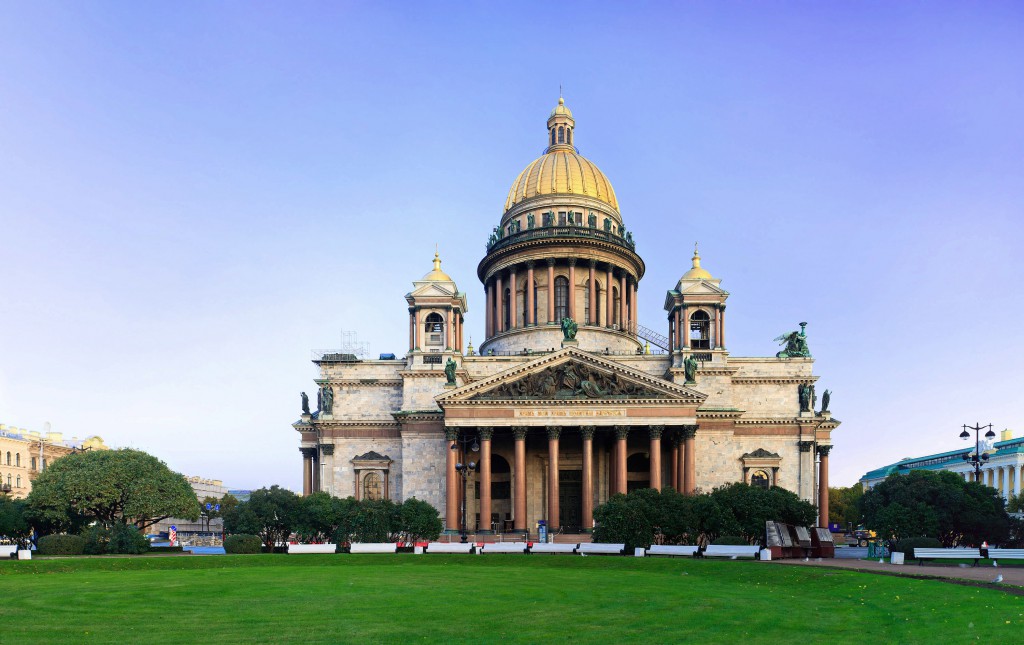
Dome
The cathedral’s main dome rises 101.5 metres (333 ft) and is plated with pure gold. The dome is decorated with twelve statues of angels by Josef Hermann. These angels were likely the first large sculptures produced by the then novel process of electrotyping, which was an alternative to traditional bronze casting of sculptures. Montferrand’s design of the dome is based on a supporting cast iron structure. It was the third historical instance of cast iron cupola after the Leaning Tower of Nevyansk (1732) and Mainz Cathedral (1826).
拱頂
大教堂的主圓頂高101.5米(333英尺),鍍有純金。 圓頂由約瑟夫·赫爾曼(Josef Hermann)裝飾著十二尊雕像或天使。 這些天使可能是新型電鑄工藝生產的第一批大型雕塑,它是傳統青銅鑄造雕塑的替代品。 Montferrand的圓頂設計基於支撐鑄鐵結構。 這是Nevyansk斜塔(1732年)和美因茨大教堂(1826年)之後鑄鐵沖天爐的第三個歷史事例。
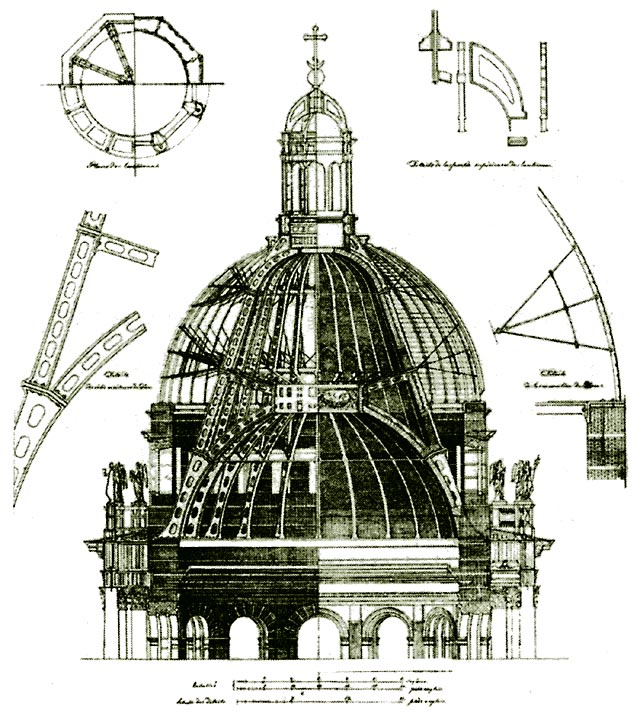
Interior
The cathedral’s bronze doors, covered in reliefs by Ivan Vitali, are patterned after the celebrated doors of the Battistero di San Giovanni in Florence, designed by Lorenzo Ghiberti. Suspended underneath the peak of the dome is a sculpted white dove representing the Holy Spirit. Internal features such as columns, pilasters, floor, and statue of Montferrand are composed of multicolored granites and marbles gathered from all parts of Russia. The iconostasis is framed by eight columns of semiprecious stone: six of malachite and two smaller ones of lazurite. The four pediments are also richly sculpted.
The interior was originally decorated with scores of paintings by Karl Bryullov and other great Russian masters of the day. When these paintings began to deteriorate due to the cold, damp conditions inside the cathedral, Montferrand ordered them to be painstakingly reproduced as mosaics, a technique introduced in Russia by Mikhail Lomonosov. This work was never completed.
室內
大教堂的青銅門由伊凡維塔利(Ivan Vitali)的浮雕覆蓋,在佛羅倫薩的Battistero di San Giovanni的著名大門之後,由Lorenzo Ghiberti設計。 在穹頂的高峰期暫停,聖靈代表聖靈。 柱子,壁柱,地板和Montferrand雕像等內部特徵由來自俄羅斯各地的多彩花崗岩和大理石組成。 聖像是由八列半寶石構成的:六個孔雀石和兩個較小的la石。 這四個山形牆也是雕刻豐富的。
內部最初裝飾有Karl Bryullov和當時其他偉大的俄羅斯大師的數十幅畫作。 當這些畫作由於大教堂內寒冷潮濕的環境而開始下降時,蒙費朗命令將它們精心複製為馬賽克,這是米哈伊爾·羅蒙諾索夫在俄羅斯引入的一種技術。 這項工作從未完成。
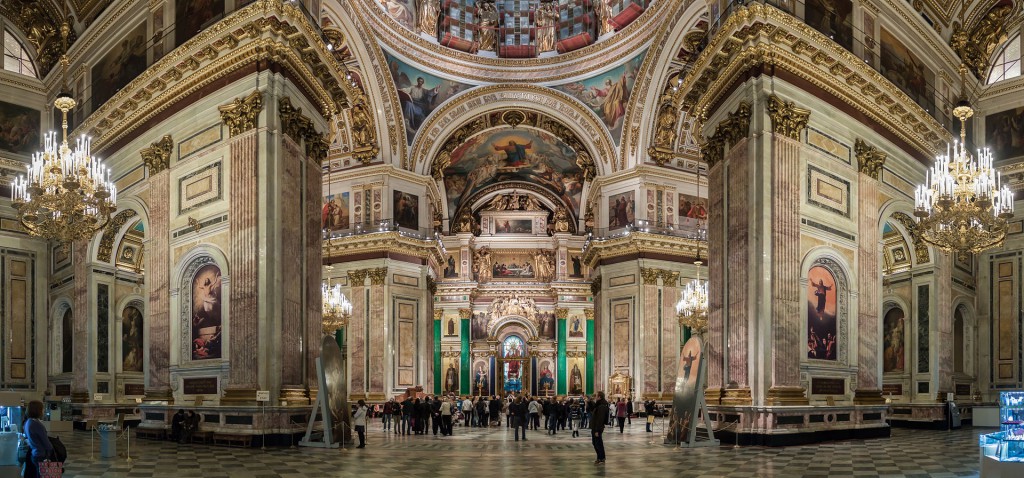
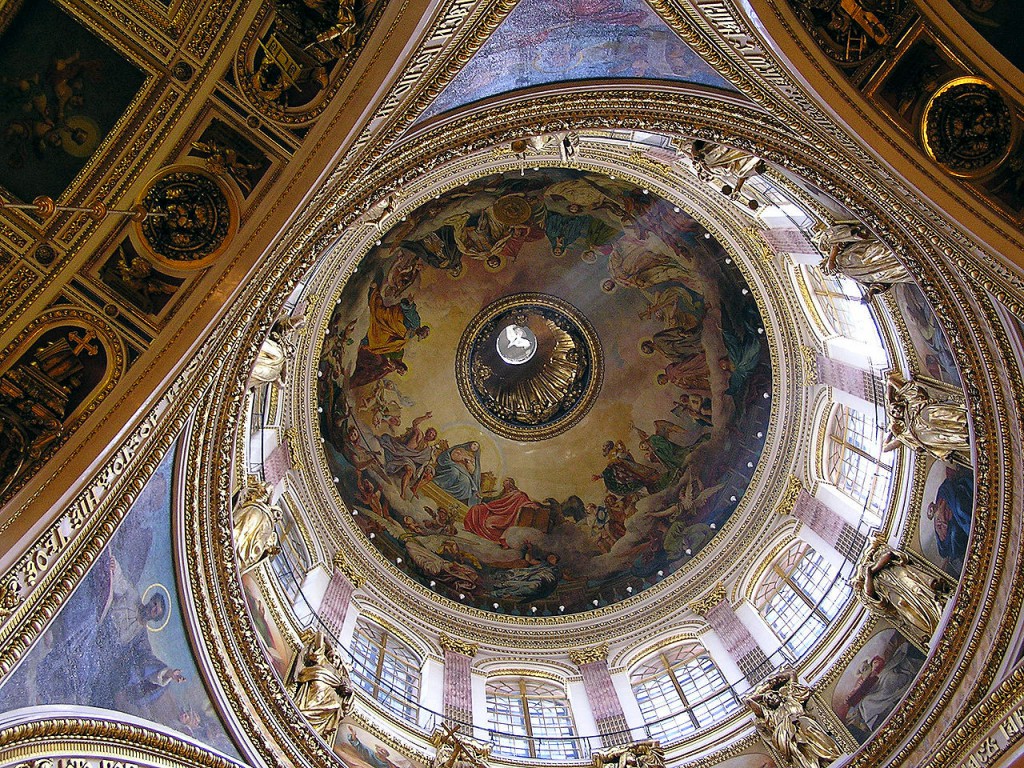
Technologies
William Handyside and other engineers used a number of technological innovations in the construction of the building. The portico columns were raised with the use of large wooden frameworks before the walls were erected. The building rests on 10,000 tree trunks that were sunk by a large number of workers into the marshy banks upon which the cathedral is situated. The dome was gilded by a technique similar to spraypainting; the solution used included toxic mercury, the vapors of which caused the deaths of sixty workers.The dozen gilded statues of angels, each six metres tall, facing each other across the interior of the rotunda, were constructed using galvanoplastic technology,making them only millimeters thick and very lightweight. St. Isaac’s Cathedral represents the first use of this technique in architecture.
The meticulous and painstakingly detailed work on constructing the St. Isaac’s Cathedral took 40 years to complete, and left an expression in the Finnish language, rakentaa kuin Iisakin kirkkoa (“to build like St. Isaac’s Church”), for lengthy and never-ending megaprojects.
技術
William Handyside和其他工程師在建築施工中使用了許多技術創新。在牆壁豎立之前,使用大型木框架提升了門柱。該建築物依靠10,000個樹幹,這些樹幹被大量工人沉入大教堂所在的沼澤堤岸。圓頂通過類似噴漆的技術驗證;盒子使用天使雕像,每個六米高,在圓形大廳的內部彼此相對,使用電鍍技術構造,使它們只有幾毫米厚而且非常輕巧。聖艾薩克大教堂代表了這種技術在建築中的首次使用。
關於建造聖路易斯的細緻和精心細緻的工作艾薩克大教堂花了40年的時間才完成,並用芬蘭語留下了一個表達,包括Iisakin kirkkoa(“建造像聖艾薩克教堂”),用於漫長而永無止境的大型項目。
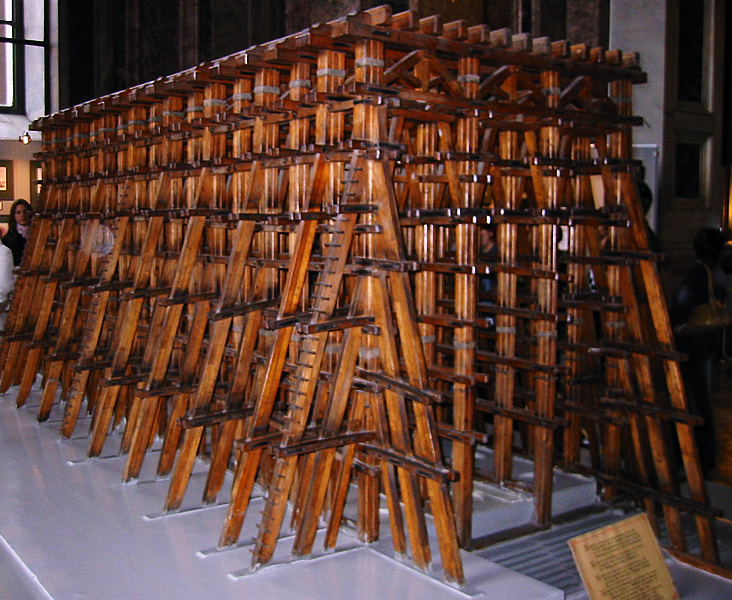
FROM:https://en.wikipedia.org/wiki/Saint_Isaac%27s_Cathedral
FROM:St Isaac Cathedral, St Petersburg
Don’t you think it’s addictive?
Want to know more about the beauty of architecture?
Come and join our members to explore the beauty of architectural design.
覺得看得不過癮嗎?
想要知道更多建築之美嗎?
快來加入我們的會員,一同探索建築設計之美。
The above article is purely for appreciation and sharing purposes, as well as the construction of new technology and the public can be in-depth understanding of the information at the same time there are sources, will be able to query, no use of the document as a commercial transaction, if illegal, please inform the We will immediately remove the site, thank you for cooperation.
以上文章純粹作為欣賞及分享用途,以及將建築新型技術傳遞給與大眾能夠深入了解,同時資料還有來源,將可查詢,絕無使用該文件資料作為商業交易行為,如有違法請務必告知該網站我們將立即處理撤除,謝謝合作。

